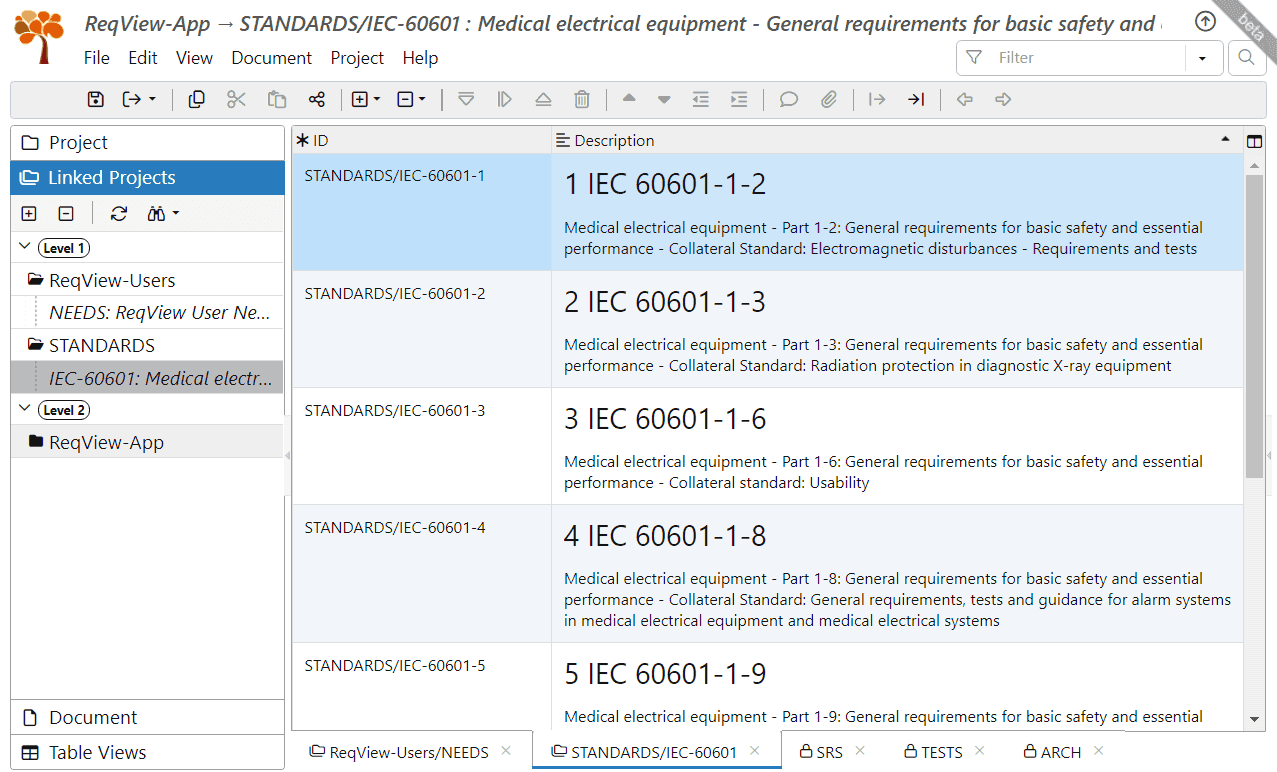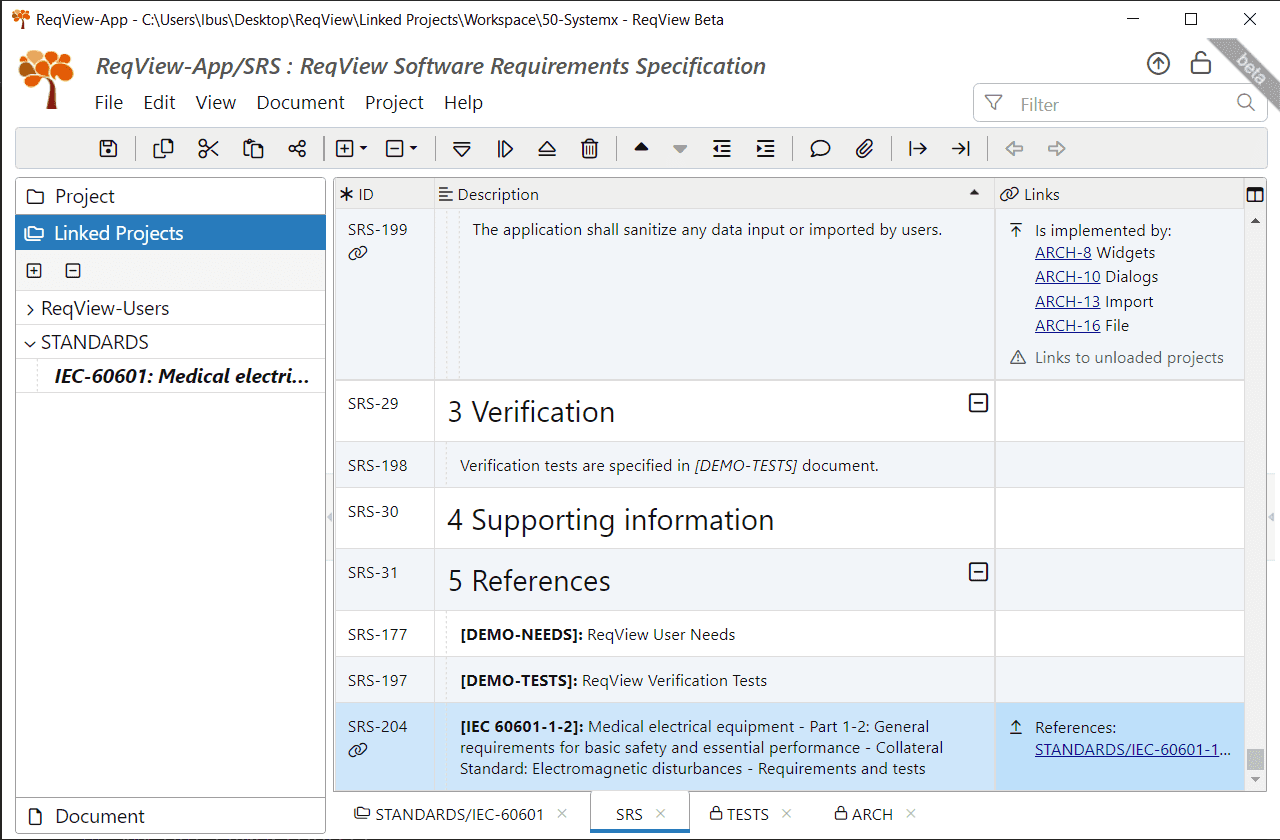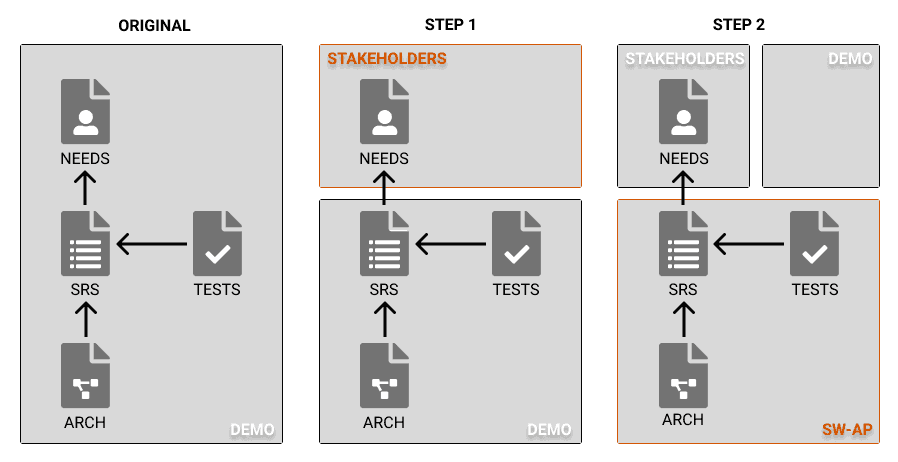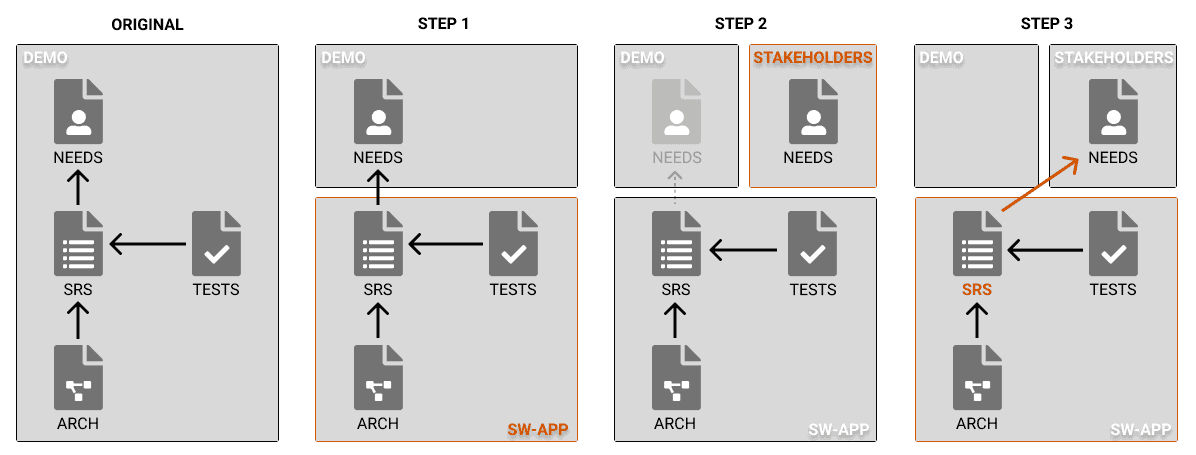You can split requirements for complex products or systems into several Linked Projects to reduce the number of documents per project, reuse requirements across the projects, and control versions of linked projects independently.
Benefits of Linked Projects
Project Breakdown
Requirements for complex systems are described on several levels of abstractions, which leads to a high number of documents. For instance, consider a system product consisting of 20 SW / HW modules and its V-model with 3 levels of abstraction, similar to the Example System Project.
A single ReqView project storing just requirements and test cases will consist of more than 40 documents. This is quite a lot of information to be managed by a single person. So you have a team of domain experts, each working mainly with just a few related requirements documents (e.g., describing only a single module).
If you organize requirements in linked projects, your team members will be able to work on the projects independently and focus better on the information they need.
Requirements Reusability
If you develop several similar products, you try to share reusable information as much as possible to save your efforts. For instance, you may want to reuse:
- external source documents
- regulatory standards
- SW / HW requirements and tests
If you extract shared requirements in a linked project, you will be able to reuse them by linking to the single source of truth.
Independent Version Control
Most system products are developed iteratively. At the end of each iteration, the current set of top-level requirements is reviewed and saved as a new version (baseline). Then downstream requirements (system or SW / HW requirements) are updated according to changed upstream requirements. Finally, downstream requirements are reviewed and saved as a new version.
If you separate requirements into linked projects by traceability levels, you will be able to manage their versions in Git or Subversion (SVN) version control system independently. Then you can benefit from connecting downstream requirements to a specific baseline of upstream requirements.
Connect Linked Projects
You can connect a project to other Project Folders or Project Files to display their content or create traceability links. Let’s call the project opened in the current window the main project and connected projects linked projects.
To connect the main project to a linked project, click Project, mouseover Linked Projects, and select Connect Folder or Connect File. Then select the path of a linked project in the dialog. Similarly, you can reconnect the main project to another linked project path later.
To disconnect a linked project from the main project, click the project in the Linked Projects pane, and select Disconnect from the menu.
Note: You can connect projects in both directions if you need to navigate between them easily.
Display Linked Projects
To display linked projects in the Linked Projects pane, click View, mouseover Left Panes, and select Linked Projects Pane, or press CtrlAltO.

The pane displays directly linked projects only by default. To explore or hide indirectly linked projects upstream or downstream, click the icon from the toolbar of the pane, and click Explore Upstream, Explore Downstream, or Hide Indirect Projects from the menu.
Linked projects are grouped in the pane by their level. To set the level of a linked project, click the project in the pane, select Edit from the menu, and in the linked project window set project properties.
To expand or collapse a linked projects group, double click on the group in the pane.
Load Linked Projects
You can load a linked project from the file system to display its documents and outgoing traceability links leading to other projects. The content of loaded linked projects is persisted for offline usage automatically. You can unload an unused linked project to reduce memory usage or to hide all traceability links that lead from this project.
To load or unload a linked project, double click on the linked project in the Linked Projects pane or click on the project in the pane and select Load or Unload from the menu.
To load or unload all linked projects in a group, click on the group in the Linked Projects and select Load All or Unload All from the menu.
Edit Linked Projects
To display a document from a loaded linked project in the current project window as read-only, click on the document in the Linked Projects pane.
Documents can only be edited in their own project window. To edit a document from a linked project, click the project in Linked Projects pane and then select Edit from the menu.
To reload all loaded linked projects from the file system or SVN repository, click Project, mouseover Linked Projects, and select Refresh All Projects. Or click the icon the toolbar of the Linked Projects pane, or press CtrlShiftR.
Create Links Between Projects
You can create traceability links from the main project to a loaded linked project using a link type defined in the main project. Traceability links are persisted in the main project, which is the link source. For instance, assume that the main project DEMO is connected to the linked project EXT as explained in the previous section. When you create traceability links from project DEMO to EXT, the links will be stored in project DEMO.
Create, edit, delete, view and navigate links between projects similarly to links within a single project, see Requirements Traceability Links.
Note: We strongly recommend that you link projects upwards, i.e., from derived to the source information. For instance, create traceability links from a project storing system requirements to the linked project storing requirements described in an industry standard.
Example: Display the Links column listing reference traceability links from document SRS in the main project ReqView-App to document IEC-60601 in the linked project STANDARDS.

Note: If there are links to an unloaded linked project, the Links column displays a warning message. For example, see the Links column for SRS-199 in the previous screenshot. Right-click the warning message to load linked projects from the context menu to display the links.
Split Existing Projects
You can move selected documents from the main project into another linked project. We recommend moving documents from top to bottom levels. The main reason is that outgoing links leading from a moved document are redirected automatically. However, if a moved document has incoming links from a linked project, the links cannot be redirected because the linked project is read-only.
To split the main project, click Project, mouseover Maintenance, and select Move Documents. In the Move Documents dialog, choose documents to move, an existing target linked project, or enter the ID of a new target project.
Example: Split the Example Project DEMO into new projects, STAKEHOLDERS and SW-APP. Move documents from top to bottom levels as recommended.

- Move document NEEDS (stakeholder requirements) from project DEMO into linked project STAKEHOLDERS. The new project will have no outgoing links to other projects. Links from the DEMO project will be redirected to document STAKEHOLDERS/NEEDS automatically.
- Move documents SRS (software requirements), TESTS (software tests), and ARCH (software design) from project DEMO into project SW-APP.
Example: Split the Example System Project with 3 traceability levels to new projects STAKEHOLDERS, SYSTEM, RISKS, SW1, SW2, …, SWn. Move documents from top to bottom levels as recommended.
- Move top-level documents (stakeholder requirements and validation tests) into a new linked project STAKEHOLDERS. The new project will have no outgoing links to other projects.
- Move risks-related documents (FMEAs) into a new linked project RISKS. The new project will have no outgoing links to other projects.
- Move 2nd level documents (system requirements and verification tests) into a new linked project SYSTEM. The new project will have outgoing links to linked projects STAKEHOLDERS and RISKS.
- For each reusable software module, move 3rd level documents (software requirements and verification tests) into a new linked project SWx. The new project will have outgoing links to linked project SYSTEM.
Bulk Redirect Links
If you move a document with incoming links from an existing linked project, then you need to redirect dangling links manually. To redirect dangling links, open the existing linked project, click Project, mouseover Maintenance, and select Bulk Redirect Links. In the Bulk Redirect Links dialog, select the current target project and document(s) and enter the new target.
Example: Split the Example Project project DEMO into new projects, STAKEHOLDERS and SW-APP. Move documents from bottom to up levels, despite the recommendation explained in the previous section.
- Move documents SRS (software requirements), TESTS (software tests), and ARCH (software design) from project DEMO into linked project SW-APP. The new project will have outgoing links to document NEEDS in the original project DEMO.
- Move document NEEDS storing stakeholder requirements from project DEMO into linked project STAKEHOLDERS. Outgoing links from project SW-APP pointing to the moved document DEMO/NEEDS will become dangling.
- To redirect dangling links, open project SW-APP in a new window, and in the Bulk Redirect Links dialog choose DEMO/NEEDS as the current target and STAKEHOLDERS/NEEDS as the new target.

Manage Project Versions
You can manage versions of ReqView projects in Subversion (SVN) version control system. For more information on how to organize SVN repositories storing ReqView linked projects see Subversion (SVN) Administration.